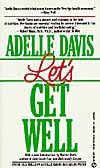1
Selye, H., The Stress of Life , McGraw-Hill, New
York, N.Y, 1956
2 J.
Am. Med. Assn. 140, 784, 1949
3
Seronde, J., et al., J. Inf. Dis. 97, 35, 1955
4
Clark, I., et al., Endocrinology 56, 232, 1955
5
Ludovici, P. P., et al., Proc. Soc. Exp. Biol. Med.
77, 526, 1951
6
Axelrod, A.E., Nut. Rev. 10, 353, 1952
7
Axelrod, A.E., et al., Ann. N.Y. Acad. Sci 63, 202,
1955
8
Axelrod, A.E., J. Nut. 72, 325, 1960
9
Barboriak, J. J., et al., J. Nut. 63, 601, 1957
10
Williams, R.J., Biochemical Individuality, Wiley, New
York, NY, 1956
11 Hodges, R.E., et al., Am. J.
Clin. Nut. 9, 244, 1961
12 Thornton, G. H., et al., J.
Clin. Invest. 34, 1073, 1955
13 Bean, W.B., et al., Proc. Soc.
Exp. Biol. Med. 86, 693, 1954
14 Hodges, R.E., et al., Am. J.
Clin. Nut. 11, 187, 1962
15 Yamada, K., et al., J.
Vitaminol. 5, 188, 1959
16 Vilter, R.W., et al., J. Lab.
Clin. Med. 42, 335, 1953
17 Pinkerton, H., et al.,
Science 89, 368, 1939
18 Woolley, J.G., et al., Pub.
Health Rep. 57, 149, 1942
19 Kligler, I. J., et al., J.
Path. Bact. 46, 619, 1938
20 Jungeblut, C.W., et al., J.
Immunol. 33, 203, 1937
21 Jungeblut, C.W., J. Exp.
Med. 70, 315, 1939
22 Klenner, F. R., Tri-State
Med. J. July 1954
23 Klenner, F. R., Tri-State
Med. J. Sept. 1956
24 Klenner, F. R., Tri-State
Med. J. June 1957
25 Klenner, F. R., Tri-State
Med. J. Oct. 1958
26 Klenner, F. R., Tri-State
Med. J. Feb. 1959
27 Klenner, F. R., Tri-State
Med. J. Feb. 1960
28 Knight, C.A., et al., J.
Exp. Med. 79, 29, 1944
29 Burkhaug, K. E., Acta
Tubercul. Scand. 13, 45, 1939
30 Steinbach, M. M., et cal,
Am. Rev. Tubercul. 43, 401, 414, 1941
31 Cottingham, E., et al., J.
Immunol. 47, 493, 1943
32 Banerjee, S., et al., J.
Biol. Chem. 190, 177, 1951
33 Stefanini, M., et al.,
Proc. Soc. Exp. Biol. Med. 75, 806, 1950
34 Madison, R. R., et al.,
Proc. Soc. Exp. Biol. Med. 37, 402, 1937
35 Madison, R. R., et al.,
Proc. Soc. Exp. Biol. Med. 39, 545, 1938
36 Cameron, G. D. W.,
Canadian Pub. Health J. 29, 404, 1938
37 Cuttle, T. D., Quart. J.
Med. 7, 575, 1938
38 Neander, G., Acta Med.
Scand. 109, 453, 1942
39 Chu, F., et al., Proc.
Soc. Exp. Biol. Med. 38, 679, 1938
40 Spink, W. N., et al., J.
Immunol. 44, 289, 1942
41 Nut. Rev. 4, 259, 1946
42 Nungester, W. J., et al., J.
Infect. Dis. 83, 50, 1948
43 Faulkner, J. M., New Engl.
J. Med. 213, 19, 1935
44 Crandon, J. H., et al., New
Engl. J. Med. 223, 353, 1940
45 Klenner, F. R., South. Med.
Surg. 110, 36, 1948
46 Klenner, F. R., South. Med.
Surg. 113, 101, 1951
47 Klenner, F. R., South. Med.
Surg. 114, 194, 1952
48 Klenner, F. R., J. Applied
Nut. 6, 274, 1953
49 Nut. Rev. 10, 217, 1952
50 McCormick, W. J., Arch. Pediat.
68, 1, 1951; 69, 151, 1952
51 Dalton, W. L., J. Ind. State
Med. Assn. 55, 1151, 1962
52 Calleja, H. B., et al, Ohio
State Med. J. 56, 832, 1960
53 Baur, H., et al., J. Am.
Med. Assn., 156, 565, 1954
54 Guggenheim, K., et al., J.
Immunol. 58, 133, 1948
55 Wissler, R. W., J. Infect.
Dis. 80, 250, 264, 1947
56 Nut. Rev. 16, 313, 1958
57 Ershoff, B. H., Nut. Rev.
13, 33, 1955
58 O'Dell, B.L., et al.,
Arch. Biochem. Beophys. 54, 232, 1955
59 Nut. Rev. 21, 170, 1963
60 Lahey, M.E., Pediat. Clin.
No. Am. 9, 689, 1962
61 Wilson, J. F., et al., J.
Pediat. 60, 787, 1962
62 Huizenga, K. A., et al., Am.
J. Med. 31, 572, 1961
63 Lehman, E., et al., J. Am.
Med. Assn. 114, 386, 1940
64 Wolf, J., Nut. Rev. 20,
161, 1962
65 Getz, H. R., et al., Am.
Rev. Tubercul. 64, 381, 1951
66 Spector, S., et al., Am. J.
Dis. Child. 66, 376, 1943
67 Brenner. S., et al., Arch.
Int. Med. 71, 482, 1943
68 Popper, H., et al., Proc.
Soc. Exp. Biol. Med. 68, 676, 1948
69 Jacobs, A. L., et al., J.
Clin. Nut. 2, 155, 1954
70 Josephs, H. W., Am. J. Dis.
Child. 65, 712, 1943
71 Green, H. N., et al.,
Brit. Med. J. 2, 595, 1931
72 Burn, C. G., et al., Yale
J. Biol. Med. 14, 89, 1941
73 Simpson, J. W., et al.,
Am. J. Obst. Gynec. 32. 125, 1936
74 Kahn, R. H., Am. J. Anat.
95, 309, 1954
75 Porter, A. D., et al.,
Brit. J. Derm. 62, 355, 1950
76 Porter, A. D., Brit. J.
Derm. 63, 123, 1951
77 Lewis, J. M., et al., J.
Pediat. 31, 496, 1947
78 Abbott, O. D., et al.,
Am. J. Physiol., 126, 254, 1939
79 Moore, T., Biochem. J.
34, 1321, 1940
80 Hoffer, A., Brit. Med. J., 1,
1342, 1962
81 King, J. D., Brit. Dent. J.
74, 113, 141, 169, 1943
82 Smith, W. J., Brit. Dent.
J. 72, 140, 1942
83 Hillman, R. W., et al,
Am. J. Clin. Nut. 10, 512, 1962
|


